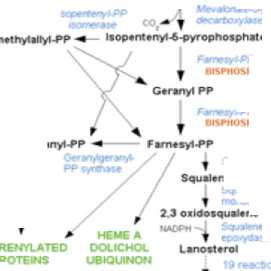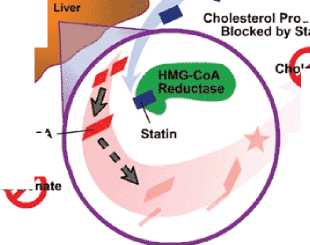49
Suresh Pichandi et al. / Int J Cur Sci Res. 2011; 1(2): 47 - 56.
Table.2. Comparative effectiveness of the Statin Drugs [3,4] ■
|
%LDLReduction |
Atorvastatin |
Statin Equivalent Dosages |
Rosuvastatin |
Simvastatin | |
|
Fluvastatin Lovastatin |
Pravastatin | ||||
|
10-20% |
- |
20 mg 10 |
10 |
- |
5 |
|
20-30% |
- |
40 mg 20 |
20 |
- |
10 |
|
30-40% |
10 mg |
80 mg 40 |
40 |
5 |
20 |
|
40-45% |
20 mg |
- 80 |
80 |
5-10 |
40 |
|
46-50% |
40 mg |
- - |
- |
10-20 |
80 |
|
50-55% |
80 mg |
- - |
- |
20 |
- |
|
56-60% |
- |
- - |
- |
40 |
- |
|
Starting dose | |||||
|
Starting dose |
10-20 mg |
20 mg 10-20 mg 40 mg |
10 mg; 5 mg if hypothyroid,>65 yo, |
20 mg | |
|
Asian | |||||
|
If higher LDL |
40 mg if |
40 mg if 20 mg if - |
20 mg if |
LDL >190 mg∕dL |
40 mg if >45% |
|
reduction goal |
>45% |
>25% >20% |
(4.87 mmol∕L) | ||
|
Optimal timing |
Anytime |
Evening With Anytime |
Anytime |
Evening | |
evening
meals
2.Mechanism of action
|
Statins act by competitively inhibiting HMG-CoA reductase,the A *HykCφA ► 3-tιydroxy√3-<nethy1fllutBrybCoA < (HMGXoA) T ∕%SZ? j HW-CoA ∕β⅛rj∣<∙ ⅛attKHy¼CaA M.,.1on⅛κ,d Sml“ Iz- АЇР T Mwaxwe*™» Mevalonate -6 -phosphate ▼ ^ MevaJonate-S-pyrophosphate DImethiyfaIIyI-PP →— Iaopontofiyl-S-Pyrophosphate (PP) BisPHOSPIKMATtS Goranyl PP J ∖ ɪ HllkPHOSPHOHATES Г 4 T GeranylQeranyf-PP ------ FarnesyI-PP Squalene 2.3 Oxldoiqualone I ’ S FiATiPh —-J Squθ⅛∏e * HEMEA I ep⅛yAκe PREtWLATEO DOLICHOL L∙noιt∙rt>l PROTEINS LieiQUINON j IS Ikaclicns CHOLESTEROL |
Fig.1.The HMG-CoA reductase pathway, which is blocked by Inhibiting cholesterol synthesis By inhibiting HMG-CoA reductase, statins block the pathway for Fig.2. Statins block the pathway for synthesizing cholesterol A ^~'~^'"^*-~",~⅛⅛ Statin . Liver / ___√1⅜¾P7 Cholesterol Production ∖c^2^°∣ Zfi Reductase f ∖ HMG-CoA ÷ ^ Statin 1 V ∖ χ4 I em∣ metlrnovie.comι- |


More intriguing information
1. Agricultural Policy as a Social Engineering Tool2. A methodological approach in order to support decision-makers when defining Mobility and Transportation Politics
3. The name is absent
4. Group cooperation, inclusion and disaffected pupils: some responses to informal learning in the music classroom
5. Modeling industrial location decisions in U.S. counties
6. Sectoral Energy- and Labour-Productivity Convergence
7. PROJECTED COSTS FOR SELECTED LOUISIANA VEGETABLE CROPS - 1997 SEASON
8. Segmentación en la era de la globalización: ¿Cómo encontrar un segmento nuevo de mercado?
9. Automatic Dream Sentiment Analysis
10. Do Decision Makers' Debt-risk Attitudes Affect the Agency Costs of Debt?